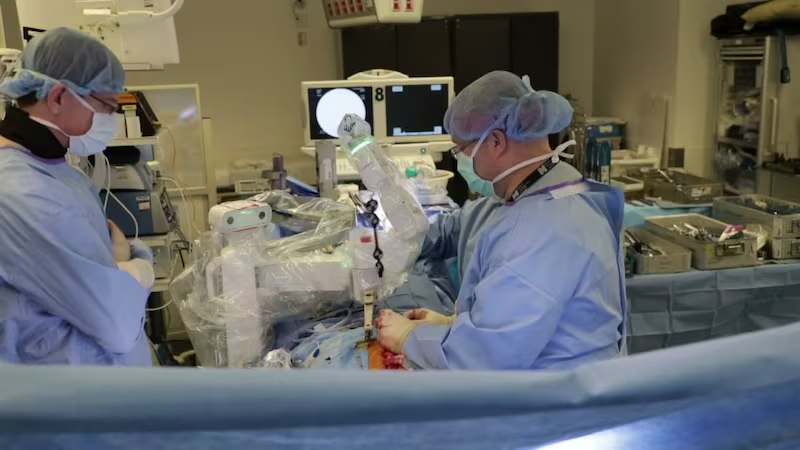Spine surgery has advanced significantly, with the emergence of robotic-assisted procedures as a groundbreaking innovation. While traditional spine surgery remains effective, robotic spine surgery offers enhanced precision, a faster recovery, and improved outcomes. Discover the key differences, pros, and cons of these approaches.
Robotic Spine Surgery
Robotic spine surgery leverages advanced technology to assist surgeons in performing procedures with enhanced accuracy and control. Robotic systems often combine pre-operative imaging and intra-operative guidance to map out a precise surgical plan, reducing the margin for error.
Key Benefits of Robotic Spine Surgery:
- Enhanced Precision: Robots facilitate high levels of accuracy by enabling millimeter-level movements, critical in spinal procedures.
- Smaller Incisions: Minimally invasive techniques result in reduced soft tissue disruption, leading to faster recovery and less post-operative pain.
- Improved Visualization: Advanced imaging provides surgeons with a clear, real-time view of the surgical field, enabling better decision-making.
- Faster Recovery Times: Patients undergoing robotic procedures often experience shorter recovery periods due to reduced tissue trauma.
Challenges of Robotic Spine Surgery:
- High Initial Costs: Advanced robotic systems require significant financial investment, potentially making them less accessible to smaller healthcare facilities.
- Prolonged Setup Times: Preparing the robotic equipment and integrating pre-operative imaging into the procedure may extend overall operating times.
- Specialized Training: Surgeons must undergo additional training to effectively operate robotic systems, adding to the learning curve.
- Potential for Mechanical Errors: While rare, technological malfunctions can occur, necessitating backup plans and a skilled surgical team.
Traditional Spine Surgery
Traditional spine surgery relies heavily on the skill, experience, and judgment of the surgeon. Utilizing time-tested techniques, it often involves larger incisions to access the affected area of the spine, allowing surgeons to manually remove damaged tissues, alleviate pressure on nerves, or stabilize the spine using implants.
Key Benefits of Traditional Spine Surgery:
- Cost Efficiency: Traditional spine surgery typically involves lower costs since it does not require advanced robotic systems or specialized tools.
- Widespread Accessibility: With no dependency on advanced technology, this approach is widely available in hospitals and surgical centers, particularly in regions where robotic systems are scarce.
- Surgeon Familiarity: Many surgeons are extensively trained in traditional techniques, providing familiarity and consistency.
Limitations of Traditional Spine Surgery:
- Larger Incisions: The procedures typically require larger incisions, which can result in increased tissue damage and longer recovery times.
- Higher Risk of Complications: The manual nature of the surgery carries higher risks of human error, particularly in complex cases.
- Less Precision: Achieving pinpoint accuracy can be challenging, especially in intricate spinal conditions.
Future Trends in Spine Surgery
Advancements in robotics and artificial intelligence are poised to redefine the landscape of spine surgery further. Emerging technologies aim to make robotic systems more intuitive, reducing setup times and increasing accessibility. On the other hand, traditional spine surgery is also evolving. Enhanced surgical tools and imaging techniques are bridging the precision gap, allowing surgeons to achieve comparable outcomes in certain procedures.
Choosing the Right Approach
Both robotic and traditional spine surgery have unique advantages and limitations. While robotic technology shines in providing precision and reducing recovery times, traditional techniques remain a cost-effective and widely available option. The choice between these approaches should be based on the patient’s specific needs, the complexity of the condition, and the available resources.
Consult a Doctor Today
Understanding the nuances of surgical options is beneficial for informed decision-making. For expert guidance tailored to your unique needs, reach out to our experienced team of spine specialists. Schedule a consultation now and take the first step toward better spinal health.
- Choosing the Right Plastic Surgeon for Your Cosmetic Procedure
- Understanding Different Types of Laser Treatments for Skin Rejuvenation
- Why a Family Dentist is Key for Maintaining Oral Health
- The Benefits of Regular Visits to a Wellness Spa
- Exploring the Emotional and Psychological Triggers of Eating Disorders


Leave a Reply